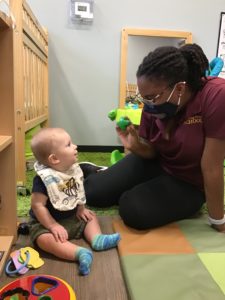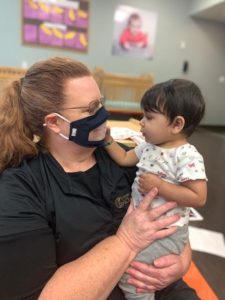Infants Learn by Watching Caregiver’s Faces
In this time of mask-wearing, it is particularly important for us to understand how infants and young toddlers learn. Young children learn an enormous amount of information from faces. From language to social cues, developmental psychologists say faces are a learning tool in the same way books are.
Since the start of the pandemic, young children have been losing out on the crucial visual tools needed for language development. While wearing masks doesn’t mean children won’t learn language, it makes it more challenging for children.
Stepping Stone School understands the crucial need for children to be able to see the formation of words and the facial features of their caregivers. To remedy that situation, we have provided clear masks to all of our infant and young toddler teachers.
When learning language, infants use the mouth to help them learn the difference between sounds such as “ba” and “da”, particularly in noisy environments. Decades of research show that young children learn unique lessons from different parts of the face. Infants as young as six months learn and understand names of new faces. With people wearing masks, it may be more difficult for young children to associate a name with a face.
In the first four to eight months of a child’s life, they primarily focus on the mouth. Then around 14 months old, when children begin word learning, they focus on the mouth again. Research has shown that five-year-old children pay close attention to mouths during conversations.
Other important features of the face for language development are the eyes. Infants pay close attention to eyes where they learn cues regarding what is important and what details they should pay attention to.
Children also learn social and emotional behaviors from the movement of multiple facial features together, such as eyebrows raising during a smile. When the entire face moves together, children learn about emotions and the identity of people.
The familiar faces of parents and caregivers are particularly important for early childhood development. Researchers suggest that parents pay special attention while at home with their young children to give them plenty of “face” time.
Some of the way’s parents can help their young children are:
- Sit and play face to face
- Talk face to face
- Sing face to face
- Make facial expressions while talking and playing
- Read a book to them while interacting with them
If everyone in a household is healthy, then not wearing a mask around your young child is incredibly beneficial. Of course, if there may be someone ill, it is crucially important to protect your children.


For more information on our Early Childhood Developmental Nurturance Program click here!